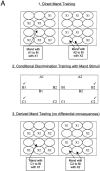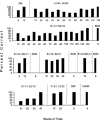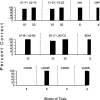Derived manding in children with autism: synthesizing Skinner's verbal behavior with relational frame theory
- PMID: 16463526
- PMCID: PMC1309708
- DOI: 10.1901/jaba.2005.97-04
Derived manding in children with autism: synthesizing Skinner's verbal behavior with relational frame theory
Abstract
Mand functions for two stimuli (A1 and A2) were trained for 3 children with autism and were then incorporated into two related conditional discriminations (A1-B1/A2 -B2 and B1-C1/B2-C2). Tests were conducted to probe for a derived transfer of mand response functions from A1 and A2 to C1 and C2, respectively. When 1 participant failed to demonstrate derived transfer of mand response functions, transfer training using exemplars was conducted. When participants had demonstrated derived transfer of mand functions, the X1 and X2 tokens that were employed as reinforcers for mand responses were incorporated into two conditional discriminations (X1-Y1/X2-Y2 and Y1-Z1/Y2-Z2). Tests were conducted for derived transfer of reinforcing functions. Finally, tests were conducted to determine if the participants would demonstrate derived manding for the derived reinforcers (present C1 and C2 to mand for Z1 and Z2, respectively). Derived transfer of functions was observed when the sequence of training and testing was reversed (i.e., training and testing reinforcing functions before mand response functions) and when only minimal instructions were provided.
Figures













References
-
- Barnes D. Stimulus equivalence and relational frame theory. The Psychological Record. 1994;50:61–81.
-
- Barnes D, Browne M, Smeets P, Roche B. A transfer of functions and a conditional transfer of functions through equivalence relations in three- to six-year-old children. The Psychological Record. 1995;45:405–430.
-
- Barnes-Holmes D, Keane J, Barnes-Holmes Y, Smeets P.M. A derived transfer of emotive functions as a means of establishing differential preferences for soft drinks. The Psychological Record. 2000;50:493–511.
MeSH terms
LinkOut - more resources
Full Text Sources
Research Materials
Miscellaneous

